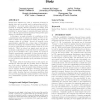3377 search results - page 108 / 676 » Spatial computation |
108
click to vote
COSIT
1999
Springer
15 years 2 months ago
1999
Springer
We extend the theory about terminological default reasoning by using a logical base language that can represent spatioterminological phenomena. Based on this description logic lang...
FLAIRS
2004
14 years 11 months ago
2004
Clustering is a form of unsupervised machine learning. In this paper, we proposed the DBRS_O method to identify clusters in the presence of intersected obstacles. Without doing an...
KDD
2006
ACM
15 years 10 months ago
2006
ACM
Spatial scan statistics are used to determine hotspots in spatial data, and are widely used in epidemiology and biosurveillance. In recent years, there has been much effort invest...
MOBIHOC
2008
ACM
15 years 9 months ago
2008
ACM
In order to better understand human and animal mobility and its potential effects on Mobile Ad-Hoc networks and Delay-Tolerant Networks, many researchers have conducted experiment...
BMCBI
2004
14 years 9 months ago
2004
Background: Hidden Markov Models (HMMs) have proven very useful in computational biology for such applications as sequence pattern matching, gene-finding, and structure prediction...

